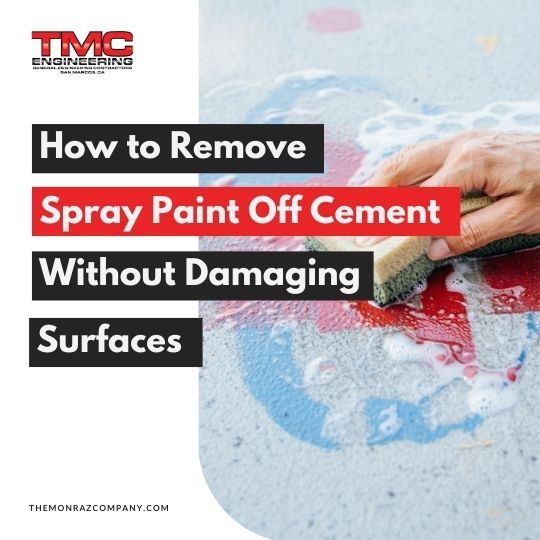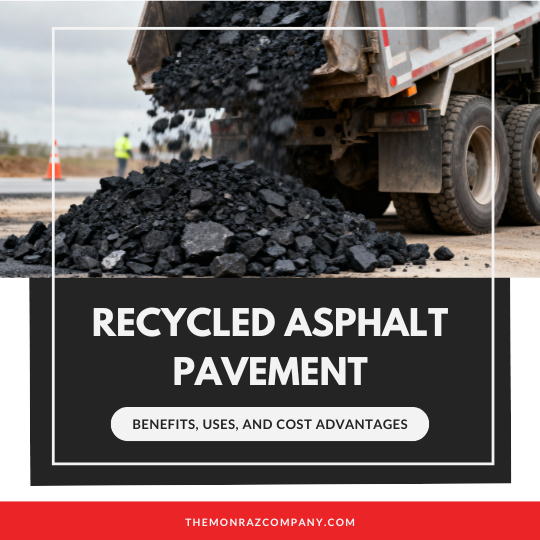Parking Lot Pothole Repair: Durable and Lasting Fixes
For commercial properties, the condition of the parking lot is a critical part of a visitor’s first impression. A well-maintained exterior reflects the dedication and commitment a business owner has to upholding high standards and attention to detail. It’s not only about aesthetics, though—an updated and preserved parking lot is also crucial for accessibility and functionality.
And, given Southern California’s unique climate and heavy traffic patterns, it’s not uncommon for a commercial business to have cracks, potholes, and various other issues. Nonetheless, neglecting these surface defects can lead to costly repairs, safety hazards, and liability issues.
Today’s post serves as a comprehensive guide on what to do when your commercial business’s parking lot has potholes. We will discuss how they form, how to fill them, and who might be responsible. Property managers and business owners who take pothole repairs seriously can protect their business, customers, and reputation all at once.
If you’re looking for answers to specific questions on parking lot pothole repairs, call the experts at
TMC
Engineering! For those located in Southern California, we can assist and educate you on construction projects that require professional input. We understand that repairs aren’t just typical maintenance—they’re a vital part of a successful, functional, and accessible property.
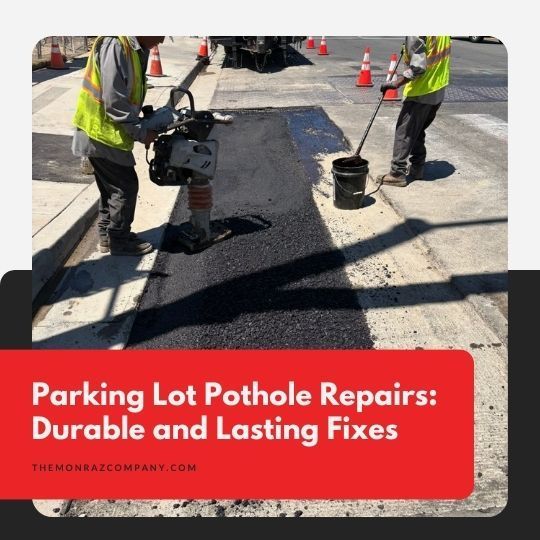
Parking Lot Pothole Repair: What You Need to Know
In this post, you can find essential information about how to manage parking lot pothole repairs. We will explore how potholes form under the diverse conditions of Southern California and the various factors that contribute to their formation.
Additionally, we will also discuss proven repair techniques that deliver lasting results. From this, you can expect a thorough explanation of the methods and materials used, as well as a step-by-step guide for successful completion.
And finally, we will address who is responsible for parking lot maintenance in various circumstances. This expertise can aid you in navigating the legal and practical aspects of property ownership. Therefore, by the end of this post, you will have all the necessary knowledge to make informed decisions about your commercial property’s maintenance needs.
For more information on pothole repairs, visit our post:
Why Is It Important
to Look Out for Potholes?
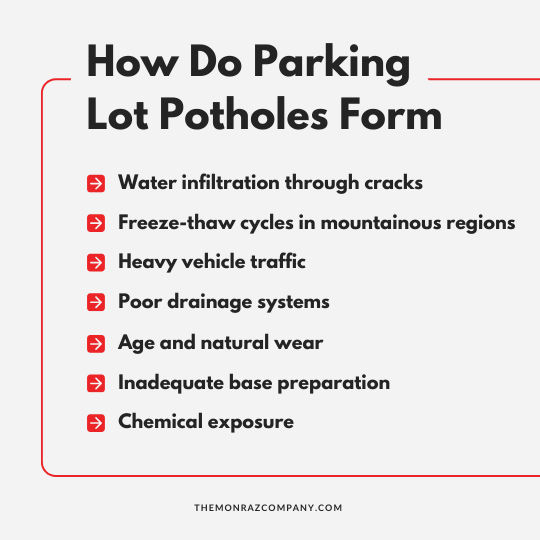
How Do Parking Lot Potholes Form?
Potholes forming within a commercial parking lot are a critical liability that property owners and managers must prioritize. Otherwise, these depressions can result in safety and liability risks that could have potentially been avoided. Understanding how potholes form is key to proactive maintenance and long-term surface integrity.
- Water Infiltration: When it rains or the nearby grass is watered, excess moisture can seep into cracks in the asphalt. Over time, this concentration of water can damage concrete, asphalt, and even brick.
- Freeze-Thaw Cycles: While Southern California generally experiences mild winters, freeze-thaw cycles can still occur and deteriorate parking lots. This occurs when moisture is absorbed into the concrete, expands when frozen, and then thaws when warm.
- Traffic Stress: A substantial traffic load, particularly from delivery trucks or heavier-weight vehicles, places consistent pressure on the concrete. Over time, this weakens the road surface due to significant stress. Furthermore, if the issue isn’t fixed promptly, it can worsen conditions and expand existing potholes.
- Poor Maintenance: A failure to address minor surface issues allows them to develop into significant problems. Routine maintenance should be a high priority for all commercial businesses to help extend the lifespan of asphalt or concrete and prevent pothole formation. For more information on taking proper preventive measures, visit our post: Asphalt Overlay: What it is & Why You Would Need It.
- Low-Grade Materials: If the parking lot was initially constructed using substandard materials or suffered improper installation, it will inevitably decline. Common issues include improperly mixed asphalt, insufficient application thickness, or inadequate compaction during installation.
For a more thorough explanation of potential causes, visit our post: What Causes Potholes In the Road?
How to Fill Potholes in Parking Lot
Potholes in commercial business parking lots can come in many shapes, sizes, and severities. Therefore, repairing them requires a structured, targeted approach. This not only guarantees that the pothole has been properly repaired but also ensures that the results are both long-lasting and durable.
Materials:
- Cold Patch Asphalt Mix: Specifically designed for immediate use. Because of this, it’s most ideal for emergency or temporary repairs. For more details, visit our post, Asphalt Cold Patch: The Ultimate Guide to Quick Pothole Repairs.
- Hot Mix Asphalt: Preferred solution for permanent repairs. Crews heat aggregates with asphalt cement and then transport the mixture to the site. We discuss this repair method in our post, “Different Types of Asphalt.”
- Tack Coat (Asphalt Binder): Used to improve adhesion between the existing pavement and the new layer. This is generally not required for cold patching asphalt.
- Crack Filler or Sealant: Necessary for sealing small cracks around the repaired area. Otherwise, those cracks could develop into another pothole before regularly scheduled maintenance occurs.
- Aggregate (Gravel, Sand, or Stone): When a pothole is particularly deep, workers place aggregate as a base layer to enhance the structural integrity of the repair. This approach ensures durability and resistance to degradation.
- Compaction Equipment: Tampers, rollers, and vibrating plate compactors all assist in creating a stable, durable foundation. This tool eliminates any air pockets within the application and smoothes the repair area for even distribution.
- Cleaning Tools: Necessary to clean debris from the repaired area. Not only does this enhance the look of the parking lot, but it also maintains accessibility and safety standards.
Instructions:
- Step 1: Clear the area.
Before starting, clear the area of all debris, dirt, water, and broken pavement with a broom, shovel, or air blower. Otherwise, the debris can disrupt the process and potentially mandate a restart.
- Step 2: Assess the edges.
Most potholes, naturally, will not be clean-cut. In this case, cut the edges to create a square or rectangular shape. The clean lines will make repairs much easier and ensure the patched asphalt will not crack around irregular boundaries.
- Step 3: Prepare the base.
For deeper potholes, it’s essential to fill them with aggregate. If the pothole is improperly filled, the foundation may not be stable, and the asphalt will prove unsuccessful. Make sure to compact each layer thoroughly.
- Step 4: Apply tack coat (if necessary).
If using a hot mix asphalt for your pothole repair, use a tack coat or asphalt binder. Apply it to the inner walls and base of the pothole. This allows the old and new material to bind together, which is vital for long-term success.
- Step 5: Fill the pothole.
Pour the asphalt mix into the pothole, slightly overfilling to allow for compaction afterwards. Make sure to distribute the mixture evenly for uniform coverage.
- Step 6: Level the surface and compact the material.
Once the asphalt mix has been added, use a rake or shovel to double-check your work. The mixture should be evenly spread and level with the surrounding surface. Then, use a hand tamper for smaller repairs, or a plate compactor for larger areas. Proper compaction guarantees that the repair blends evenly with the existing surface.
- Step 7: Seal the edges.
Once the repair area has cured, apply asphalt sealer around the perimeter of the repair. This prevents water infiltration, protecting the surface against further damage.
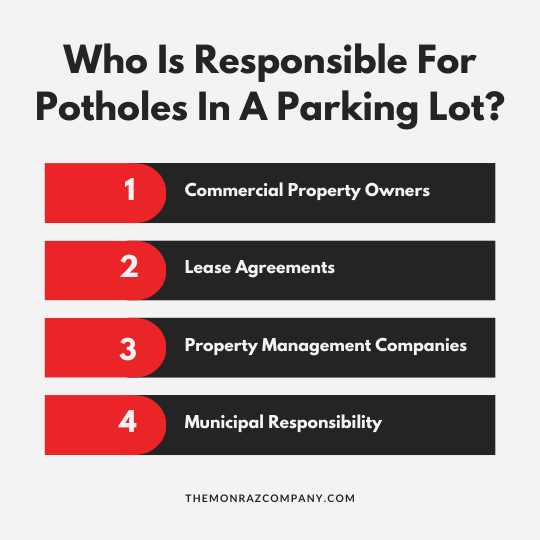
Who Is Responsible for Potholes in a Parking Lot?
Property ownership and maintenance responsibility can be complex, and typically vary from state to state. In Southern California, responsibility generally falls upon the property owner or the party assigned to maintenance. However, determining liability may depend on external circumstances or property agreements.
Here is a review of stakeholders who may be liable for the responsibility:
- Commercial Property Owners: Typically, the property owner or landlord will be held liable for improper maintenance. This also includes any injuries or accidents that take place on the property.
- Commercial Tenants: In the case of leasing and/or renting a property, liability can vary. In some cases, the tenant will be held responsible for routine maintenance—including the repairs of potholes. This is particularly true in triple-net (NNN) lease arrangements, which are common throughout Southern California. In other cases, the tenant may share the cost through common area maintenance fees.
- Property Management Company: If a third-party entity, such as a property management company, is contracted to oversee the property, they may assume responsibility for maintaining common areas. However, this is highly dependent on the terms of the management agreement. Specific contracts and state laws most often define liability.
- Municipal Entities: For parking lots owned or operated by city agencies, liability ultimately falls on the government entity. Private commercial parking lots remain the owner’s responsibility regardless of public access.
Additionally, Southern California business owners and property managers should also be aware of and abide by both the California Building Codes (CBC) and The Americans with Disabilities Act (ADA). Regular maintenance and smooth, stable surfaces are crucial for ensuring accessibility, minimizing liability, and maintaining compliance. Failure to do so can result in safety hazards and potential legal consequences.
Proper pothole maintenance is a critical aspect of managing a commercial property effectively.
When managing a commercial property in Southern California, the diverse climate can pose unique challenges. However, understanding what causes potholes and how to successfully fix them is essential for upholding standards and maintaining compliance.
Whether your commercial property requires
asphalt parking lot repair or
concrete parking lot repair, the
team of experts at TMC Engineering knows how to help. We understand that your parking lot represents your property’s functionality and appearance, which is why we ensure every repair project meets the highest standards. Through safety, quality workmanship, and client satisfaction, we guarantee that every project will exceed your expectations and meet local California requirements.
